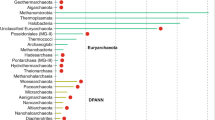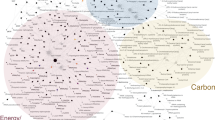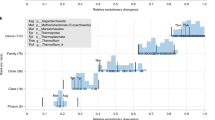Abstract
The archaebacteria are a group of prokaryotes which seem as distinct from the true bacteria (eubacteria) as they are from eukaryotes1–4. The evidence on which this conclusion rests is of two types: genotypic (quantitative)—that is, comparative sequence studies, and phenotypic (qualitative)—that is, differences in various organismal characteristics. The differences between archaebacteria and true bacteria are so great, both quantitatively and qualitatively, that the two bacterial groups should be considered as representing separate primary lines of descent, each tracing directly back to the universal ancestor1,4. Furthermore, this ancestor itself seems not to be a prokaryote; rather it was a far simpler type of organism, one properly called a progenote5,6. If this is true, the discovery of archaebacteria marks a major advance in the biologist's attempts to understand the basis for the evolution of the cell.
This is a preview of subscription content, access via your institution
Access options
Subscribe to this journal
Receive 51 print issues and online access
$199.00 per year
only $3.90 per issue
Buy this article
- Purchase on Springer Link
- Instant access to full article PDF
Prices may be subject to local taxes which are calculated during checkout
Similar content being viewed by others
References
Woese, C. R. & Fox, G. E. Proc. natn. Acad. Sci. U.S.A. 74, 5088–5090 (1977).
Woese, C. R., Magrum, L. J. & Fox, G. E. J. molec. Evol. 11, 245–252 (1978).
Balch, W. E., Fox, G. E., Magrum, L. J., Woese, C. R. & Wolfe, R. S. Microbiol. Rev. 43, 260–296 (1979).
Fox, G. E. et al. Science 209, 457–463 (1980).
Woese, C. R. Symp. Soc. gen. Microbiol. 20, 39–54 (1970).
Woese, C. R. & Fox, G. E. J. molec. Evol. 10, 1–6 (1977).
VanValen, L. M. & Maiorana, V. C. Nature 287, 248–250 (1980).
Margulis, L. Origin of Eucaryotic Cells (Yale University Press, New Haven, 1970).
Stanier, R. Y. Symp. Soc. gen. Microbiol. 20, 1–38 (1970).
Murray, R. G. E. in Bergey's Manual of Determinative Bacteriology 8th edn (eds Buchanan, R. E. & Gibbons, N. E.) (Williams & Wilkins, Baltimore, 1974).
Kandler, O. & König, H. Archis Microbiol. 118, 141–152 (1978).
Kandler, O. Naturwissenschaften 66, 95–107 (1979).
Gupta, R. & Woese, C. R. Curr. Microbiol. (in the press).
Langworthy, T. A. Biochim. biophys. Acta 487, 37–47 (1977).
Tornabene, T. G. & Langworthy, T. A. Science 203, 51–53 (1979).
Zillig, W., Stetter, K. O. & Janekovic, P. Eur. J. Biochem. 96, 597–604 (1979).
Zillig, W., Stetter, K. O. & Tobein, M. Eur. J. Biochem. 91, 193–199 (1978).
Langworthy, T. A., Mayberry, W. R. & Smith, P. F. Biochim. biophys. Acta 431, 550–569 (1976).
Woese, C. R., Maniloff, J. & Zablen, L. B. Proc. natn. Acad. Sci. U.S.A. 77, 494–498 (1980).
Eperon, I. C., Anderson, S. & Nierlich, D. P. Nature 286, 460–467 (1980).
Bonen, L. & Doolittle, W. F. Proc. natn. Acad. Sci. U.S.A. 72, 2310–2314 (1975).
John, P. & Whatley, F. R. Nature 254, 495–498 (1975).
Flavell, R. Biochem. Genet. 6, 275–291 (1972).
Heckman, J. E. et al. Cell 13, 83–95 (1978).
Matheson, A. T., Moller, W., Amons, R. & Yaguchi, M. in Ribosomes: Structure, Function, and Genetics (eds Chamblis, G. et al. 297–315 (University Park Press, Baltimore, 1980).
Kessel, M. & Klink, F. Nature 287, 250–251 (1980).
Kwok, Y. & Wong, J.T-F. Can. J. Biochem. 58, 213–218 (1980).
Steitz, J. A. Nature 273, 10 (1978).
Woese, C. R. & Fox, G. E. Nature 273, 101 (1978).
Author information
Authors and Affiliations
Rights and permissions
About this article
Cite this article
Woese, C., Gupta, R. Are archaebacteria merely derived ‘prokaryotes’?. Nature 289, 95–96 (1981). https://doi.org/10.1038/289095a0
Received:
Accepted:
Issue Date:
DOI: https://doi.org/10.1038/289095a0
This article is cited by
-
A pursuit of lineage-specific and niche-specific proteome features in the world of archaea
BMC Genomics (2012)
-
Discovering novel biology by in silico archaeology
Nature Reviews Microbiology (2005)
-
Unique antibiotic sensitivity of an in vitro polypeptide synthesis system from the archaebacterium Thermoplasma acidophilum. Phylogenetic implications
Molecular and General Genetics MGG (1987)
-
Intralineage diversity of archaebacterial ribosomes: A dichotomy of ribosome features separates sulfur-dependent archaebacteria and methanococcaceae from other archaebacterial taxa
Journal of Molecular Evolution (1986)
-
Aspects of biological evolution based on molecular data sets
Proceedings: Animal Sciences (1984)
Comments
By submitting a comment you agree to abide by our Terms and Community Guidelines. If you find something abusive or that does not comply with our terms or guidelines please flag it as inappropriate.



